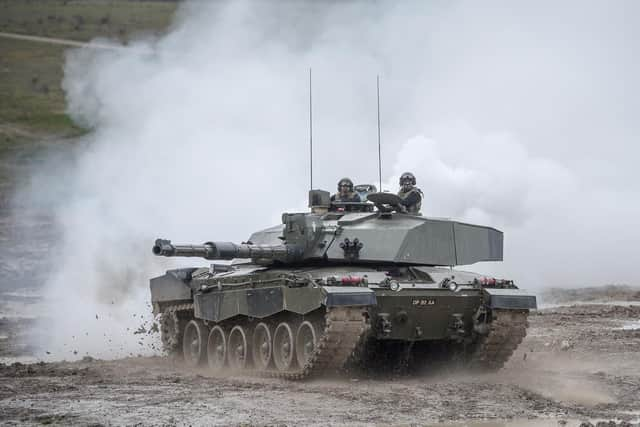War in Ukraine: The factors behind Germany's agonising decision to send Leopard 2 tanks to Ukraine
German Chancellor Olaf Scholz confirmed he had approved the supply of the Leopard 2 to Kyiv, which would also allow other allies operating the tanks to re-export them.
Since the Russian invasion, Ukraine, led by calls from president Volodymyr Zelensky, has been crying out for supplies, aid, weapons and fighter jets.
Advertisement
Hide AdAdvertisement
Hide AdWhile many countries have responded with supplies, there has not been the universal and steady stream from the Western world some may have been expecting. Indeed calls for modern fighter jets have still gone unanswered, with none delivered to Ukraine thus far. However, the announcement to send heavy tanks from Germany has already triggered further support..


The US confirmed last night it would send 31 M1 Abrams battle tanks to Ukraine, senior administration officials said, reversing months of persistent arguments by the Biden administration the tanks were too difficult for Ukrainian troops to operate and maintain.
Germany had said the Leopards would not be sent unless the US put its Abrams on the table, not wanting to incur Russia’s wrath without the US similarly committing its own tanks.
Since then, both sides had participated in “good diplomatic conversations” that had made the difference and were part of the “extraordinary shift in Germany’s security policy” over providing weapons to Ukraine since Russia invaded 11 months ago, said a senior administration official.
The $400 million (£323m) package announced on Wednesday also includes eight M88 recovery vehicles – tank-like tracked vehicles that can tow the Abrams if it gets stuck.
Prime Minister Rishi Sunak subsequently held talks with US oresident Joe Biden, French president Emmanuel Macron and Mr Scholz on Wednesday. He also spoke to Italian prime minister Giorgia Meloni.
A Downing Street spokeswoman said: “The Prime Minister welcomed the decisions by allies to announce major battle tank contributions and updated on the UK’s unwavering support for Ukraine, including his decision to donate a squadron of Challenger 2 tanks last week. “This decisive, collective action would be a catalyst for other countries to follow suit, the Prime Minister added.
Morale amongst those fighting in Ukraine, desperate for heavy armour to ward off the Russians, had threatened to reach an all-time low as the phrase “Scholzing” – defined as communicating good intentions, only to find any reason imaginable to delay them – became a common phrase for commentators in describing the political stalemate around supplying Ukraine in Europe.
Advertisement
Hide AdAdvertisement
Hide AdGermany has often been accused by others of not being fully supportive of the Ukrainian war effort, despite being the third-largest weapons supplier to Kyiv after the US and Britain.
Germany has given Ukraine vital air defence systems, such as IRIS-T and Patriot surface-to-air missiles, as well as armoured personnel carriers, but had still been criticised for an apparent slow support that an unwillingness to partake in photo opportunities, unlike those seized by Boris Johnson and Mr Macron, may have added to.
But in reality, the nation has arguably been the European country with the most drastic policy shifts since the conflict began. Last year, Chancellor Olaf Scholz scrapped decades of Germany’s military policy for the nation to respond to the war in Europe, with defence spending dramatically increasing and weapons sent to a war zone for the first time since the Second World War.
The nation faced months of political debate around concerns that sending the Leopard tanks, which are made in Germany and under regulations had to have German approval to be sent, would escalate the conflict.
There was also concern about relations with Russia. Germany has been hit hardest by the de-facto end of Russian gas supplies to western Europe, and the nation was left scrambling for solutions after the gas supply from the Nord pipeline was halted.
However, a warm winter and brimming gas supplies believed to be close to 90 per cent have left room for political manoeuvring for Mr Scholz.
Russian ambassador to Germany Sergey Nechayev on Wednesday called Berlin’s decision to send Leopard 2 tanks to Ukraine “extremely dangerous”.
Mr Nechayev said in an online statement the move “shifts the conflict to a new level of confrontation and contradicts the statements of German politicians about their reluctance to get involved in it”.
Advertisement
Hide AdAdvertisement
Hide Ad“We’re seeing yet again that Germany, as well as its closest allies, is not interested in a diplomatic resolution of the Ukraine crisis,” he said.
Ms Scholz has had to deal with the court of public opinion. A poll for German broadcaster ARD carried out last week showed 46 per cent of Germans favoured supplying Ukraine with the Leopard 2 tanks, while 43 per cent opposed.
The Leopard 2 tanks were specifically designed to compete with the Russian T-90 tanks, which are being used in the invasion. There are believed to be more than 2,000 of them worldwide, with Mr Zelensky claiming about 300 of them would help ensure a Russian defeat.
Until now, the US has resisted providing its own M1 Abrams tanks to Ukraine, citing extensive and complex maintenance and logistical challenges with the high-tech vehicles.
Washington has said it would be more productive to send German Leopards since many allies have them and Ukrainian troops would need less training than on the more difficult Abrams.
One thing defence secretary Lloyd Austin has been very focused on, he said, “is that we should not be providing the Ukrainians systems they can’t repair, they can’t sustain, and that they, over the long term, can’t afford, because it’s not helpful”.
For the Abrams to be effective in Ukraine, its forces will require extensive training on combined arms manoeuvre – how the tanks operate together on the battlefield, and on how to maintain and support the complex, 70-ton weapon.
Comments
Want to join the conversation? Please or to comment on this article.